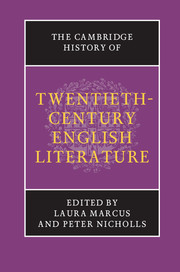Book contents
- Frontmatter
- Introduction
- PART ONE WRITING MODERNITY
- 1 Science and knowledge at the beginning of the twentieth century: versions of the modern Enlightenment
- 2 The Victorian fin de siècle and Decadence
- 3 Empire and modern writing
- 4 The gender of modernity
- PART TWO THE EMERGING AVANT-GARDE
- PART THREE MODERNISM AND ITS AFTERMATH, 1918–1945
- PART FOUR POST-WAR CULTURES, 1945–1970
- PART FIVE TOWARDS THE MILLENNIUM, 1970–2000
- Bibliography
- Index
- References
4 - The gender of modernity
from PART ONE - WRITING MODERNITY
Published online by Cambridge University Press: 28 March 2008
- Frontmatter
- Introduction
- PART ONE WRITING MODERNITY
- 1 Science and knowledge at the beginning of the twentieth century: versions of the modern Enlightenment
- 2 The Victorian fin de siècle and Decadence
- 3 Empire and modern writing
- 4 The gender of modernity
- PART TWO THE EMERGING AVANT-GARDE
- PART THREE MODERNISM AND ITS AFTERMATH, 1918–1945
- PART FOUR POST-WAR CULTURES, 1945–1970
- PART FIVE TOWARDS THE MILLENNIUM, 1970–2000
- Bibliography
- Index
- References
Summary
‘Modernity’ is a relatively new term in literary scholarship on the turn of the twentieth century. Sociologists organise their research around issues of ‘modernisation’ unique to this period: the Taylorisation of industrial production, the professionalisation of science and the organisation of the modern research university, the development of new mediums and media for both mass transportation and mass communication, and the impact on the conceptualisation of a public sphere of women’s and non-whites’ advocacy for an extension of the rights of citizenship to previously excluded populations. Sociologists focus as well on the ‘dramatic transformations of worldviews and philosophies’ encompassed by the still broader term ‘modernity’ (290). By contrast, literary scholars typically have mapped late nineteenth- and early twentieth-century history in terms of a neat, clean and emphatically teleological succession of literary movements, charting a ‘progress’ from realism to either naturalism or aestheticism and Decadence and then to Modernism. Rather than entertaining the possibility that these aesthetic modes can exist simultaneously in the same text, or that they were produced and marketed for different audiences throughout this period, the emphasis until quite recently has been placed on literary Modernism’s success in ‘extricat[ing] itself and our epoch from the fin de siècle’. That is to say, artists and literary critics claiming Modernism to be the aesthetic of modernity first established its position front-and-centre in the cultural landscape by putting other aesthetic paradigms either ‘behind’ it or ‘below’ it (or both).
- Type
- Chapter
- Information
- Publisher: Cambridge University PressPrint publication year: 2005
References
- 1
- Cited by



